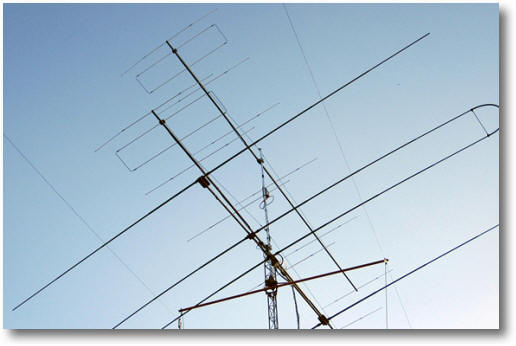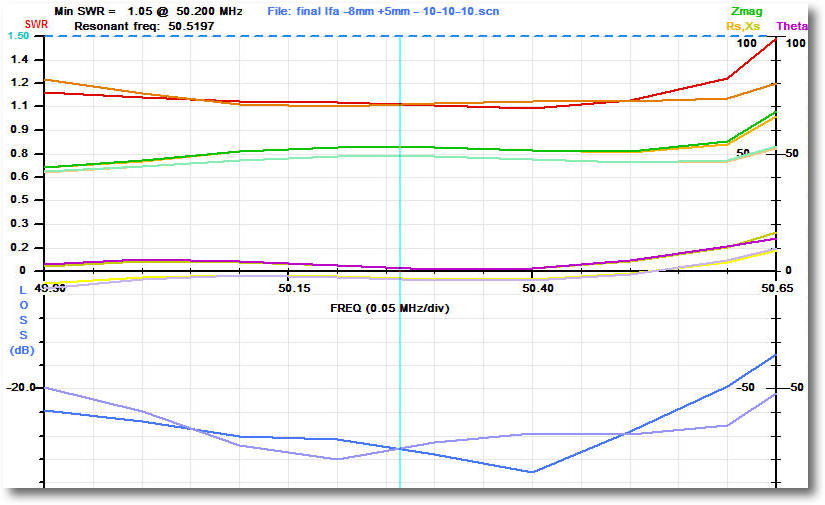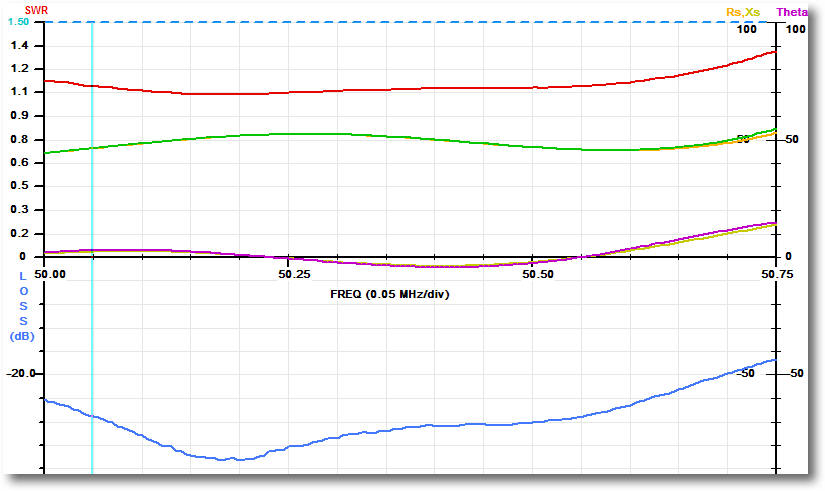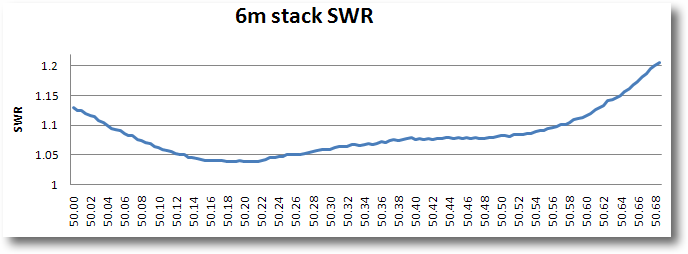An alternative to the 6M7JHV antenna for 6m / 50MHz
Comparing G3WOS's and G4CCZ's stacks
Paul, G4CCZ, took a slightly different tack to building his antennas to myself due to limitations in the size of his garden. He slit his boom into three, rather than my two. Although this does increase build complexity, it does aid manageability when assembling the stack on the tower.

Paul, G4CCZ's stack
Other than the above, our antennas were identical and when Paul analyzed his stack when first hoisted in the air he found it to be very similar to what I had seen in the final AIM plot here.
And, typical of Justin, G0KSC was just not happy with this so he he undertook another EZNEC analysis with our exact spacing and came back with some changes.
Now this is interesting, as both Paul and myself decided to use telescoped elements made from 1/2" and 3/8" tubing rather than going for a simpler method of just using 3/8" tube. Our recommendation, when building a stack, is to use this method of construction as it allows the implementation of small corrections that can have a dramatic impact on the performance of the antennas. Throughout the design and build of this stack, Justin's EZNEC modelling has proved to be impressively accurate.
Based on our under stacking distance, Justin's modelling indicated that we should reduce the size of the loop by 3mm and increase the length of director 1 by 5mm (both on each size) from the original single antenna design. The change in SWR performance was worth having with the stack now having an SWR of less than 1.1:1 from 50.050MHz through to 50.57Mhz. To quote Justin on the changes:
"The two antennas being placed closer together has caused the impedance of the stacked antennas to increase. Director 1 is the impedance controller and altering this length of this element will increase and decrease impedance. Increasing the length of D1 has lowered the impedance much closer to the required 50 Ohm without any dramatic effect on the antennas performance.
Individually ,the antennas do not require any lengthening of D1, nor would this be required if the antennas where spaced closer to their optimum. This is simply a fine-tuning activity focused on the search perfection!
To confirm, even without adjusting Director 1, the return loss of the stack would equal no more than around 1.2% (assuming a 1.2:1 worst case SWR) and therefore most hams would be happy with this."
Even more impressive and testimony to the replicability of LFA designs was that G3WOS's and G4CCZ's antennas had almost exactly the same performance even though they were built independently.
The plots below show the performance of the two stacks overlaid and you can see how close they have turned out to be! The red line is G4CCZ's stack and the orange line is G3WOS's.

G3WOS's and G4CCZ's two-antennas stacks compared.
To close, I would just like to quote from Justin's email when he saw the above plots.
"All in all I am very impressed with both sets of antennas which you have obviously built to very tight tolerances. It impresses the hell out of me that within the design frequency range (50 to 50.4MHz), both antenna stacks track one another almost to the point that you cannot see the second trace either side of the first!
Also, both antennas show return loss in excess of -30dB on large portions of the band, this is very impressive numbers and equals fractions of a % of returned power..."
I think it fair to say that both Paul and I are really pleased with the results of our efforts and are both impressed with the performance and accuracy of G0KSC's modelling and are most happy to recommend the use of LFA2 designs.
This is G3WOS's stack using the divider rather than the phasing harness.

The final G3WOS stack using the power divider rather than a phasing harness.
This is a plot of the SWR against frequency. This was achieved by adding 3mm to each end of the Director 1 and reducing the loop width by 8mm each end to correct for the under stacking.

Final stack SWR plot
Of course, Justin G0KSC came back and said "now if you just adjust this you can get it even better....."
Now - bring on the DX!